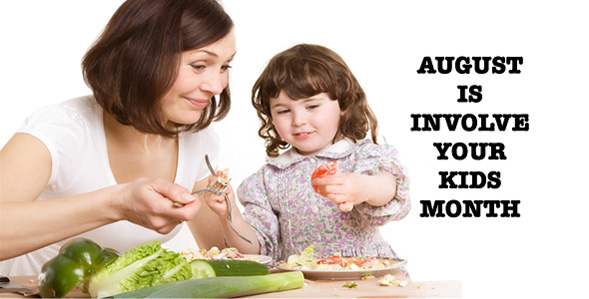August seems to come and go so quickly. Many of us are enjoying the last moments of fun in the sun with our kids while others can’t wait for our little darlings to go back to school. No matter what camp you are in, and I vacillate between the two, take some time this month to involve your children in all aspects of food.
Just like animals in the wild, we are our kids’ primary source of information when it comes to food. It is fascinating to watch a polar bear teaching her cubs how to hunt for themselves. She pounces on ice to hunt fish and seals underneath and then will tear it apart once she has caught it. That mother polar bear is teaching her cubs what they need to eat, how to hunt for it and how to eat it. Our children need to learn how to plan, shop and prepare food too. It is never too early to start as long as you are careful. As soon as my boys were able to stand at the kitchen counter I gave them a job to do; washing vegetables and biting into them were their favorite activities. It helped them to learn by interacting with a new food in a playful and non-stressful manner.
I see lots of kids today that are so afraid to try new food that they start to shake just when you show them the new food. If your child is fearful of trying anything that they have not eaten before, make sure that you let them interact with the new food before you ask them to eat it. Having your child help you to select a recipe, pick a new vegetable or fruit to try at the market, and/or wash the new vegetable at home, will help your child to familiarize themselves with that new food before they are asked to eat it. A sticker chart works wonders here for the younger child: place a finger, a nose and a mouth in one of three columns on a sheet of paper. Your child gets to place a sticker under the column when they touch the new food, smell the new food and finally work their way up to taste the new food.
Children also benefit greatly from learning where food comes from so that they are able to see the difference between what food is supposed to look like and the highly processed stuff that passes for food a lot of the time. Explain where foods comes from when you are both at the market or better yet, plant a small garden or shop at a farmers market. You don’t want your kids to grow up thinking chicken comes in nice neat packages, potatoes are always sliced into chips or fires, or it’s OK to eat food that glows in the dark or stains their mouths a neon green.
The more involved you children are in all aspects of food, the better chance you will have of bringing up a healthy eater. Even eating as a family has long lasting impact on children. When children leave the home in their twenties, they will eat a healthier diet away from home if they came from families that ate together as compared to families that did not. Wherever you are, start there. If you don’t eat together at all, try to eat together as a family just one night a week and work your way up to what works for your family.




 Dr. Debbie Kennedy (Dr. Deb) is a pediatric nutritionist with 23 years of experience in the field. She has worked with both Yale and Columbia Universities, and has developed programs for some of the industry’s luminaries such as Dr. David Katz and Dr. Mehmet Oz.
Dr. Debbie Kennedy (Dr. Deb) is a pediatric nutritionist with 23 years of experience in the field. She has worked with both Yale and Columbia Universities, and has developed programs for some of the industry’s luminaries such as Dr. David Katz and Dr. Mehmet Oz. 


Speak Your Mind